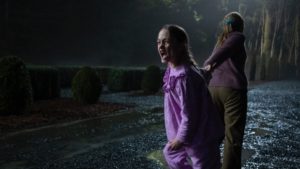
When filmmaker Mike Flanagan needed a cinematographer for the last four episodes of his Netflix limited series, The Haunting of Bly Manor, he called upon Cinematographer James Kniest, who previously shot his Netflix film, Hush.
The Haunting of Bly Manor is a new take on Henry James’ The Turn of the Screw, the classic horror tale that has been remade and reworked many times, including the 1961 film The Innocents, numerous TV movies, plays and another recent adaptation, The Turning, released earlier this year.
Below the Line spoke with Mr. Kniest a little over a week ago, and besides speaking about the challenges of coming onto the series midway through, we also spoke about the challenges that COVID-19 introduced to filming and post, and how both things are changing for DPs as many people start watching movies on laptops, tablets and even smartphones.
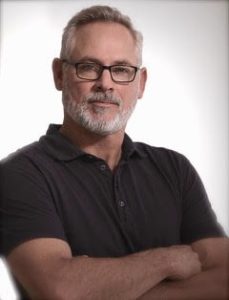
Below the Line: I know you’ve worked with Mike before, so did he bring you in to shoot the last four episodes of the series?
James Kniest: Yeah, there was another DP that started the show, and then he went off to do something else and kind of left the opening. Actually, Trevor Macy, the producer, who I’d done Hush with Mike Flanagan, and also the Bye Bye Man with Stacy Title. Trevor and I had a relationship, and we were talking about something else, and this opportunity opened up, and he said, “Can you get on a plane like tomorrow?” And I was like “How about in three days?” and I went straight to Vancouver and dove right in and made the best of it as I could, given that they had already established a lot of stuff but definitely made some changes. I tried to make things a little bit more genre and darker and a little bit more stylized.
Episode Eight was really great, because it was really fun. It was kind of one of the things that really attracted me because I love period stuff and black and white. I can’t flip channels and not stop at a period piece of it, because of all the set decoration and cars. There’s no cars in this one, it’s 1600, but yeah, it was a really good opportunity, and Mike’s a pleasure to work with. He’s just so put together.
BTL: Mike is still very involved even when he’s not directing the episodes?
Kniest: Yeah, for the most part. He has another show he’s shooting right now. Actually, I just came back from doing some days on that up in Vancouver called Midnight Mass, but he definitely stays involved with the directors and with the producers and just makes sure there’s some continuity throughout every episode.
BTL: I guess with the cinematographer, they try to keep one on for an entire season or series because they’re often changing directors, so they want to keep the look consistent by keeping the same DP.
Kniest: Usually, there’ll be rotating cinematographers; there’ll be two guys — so that they can prep with the incoming directors. The other cinematographer Maxime Alexandre, he really wanted to do the whole show, so they had already started with one cinematographer. When I came in, it was still that way. I think it’s a little hard for the incoming directors, but I would I just gave him my weekends, and we prepped on the weekends for the upcoming episodes.
BTL: And you worked with four directors, one a directing team and then two separate directors on Episode 8 and 9. Let’s talk about your first few episodes. Did you shoot them in that order or were you kind of jumping around?
Kniest: We did shoot them in order. Dan and Youlanda, they’re an Australian directing team. They’re lovely people, super put-together. They do all their homework, they’re prepared. They brought some really interesting sensibilities to the show, and they work really well together as a team. It’s kind of an interesting thing. I’ve worked in the past with some other teams, and it’s cool, because they can sort of divide and conquer. It’s always hard to get the director’s attention for all the approvals and meetings and scouts and all that kind of stuff. It’s kind of nice when there’s two, because there’s always somebody available to discuss whatever you may be approaching.
BTL: Were they both as technical in terms of handling the technical stuff? A lot of teams, one will handle the actors while the other handles the tech crew.
Kniest: Yeah, they bounced around pretty well. They usually conferred with one another, too, in a very expedited way, which is great. It wasn’t a lot of time. They have a certain shorthand that I think works well and is really fast, but they usually stayed in touch with each other about almost every aspect. There was definitely the group effort in that respect.
BTL: I’m pretty familiar with Henry James’ original work, having seen maybe four or five different adaptations, including an opera. It’s interesting to see how this one branches out, because most of the versions mainly take place in the house or on the grounds, and rarely do you see outside that.
Kniest: Yeah, this one definitely branches out. There’s quite a few locations, and there’s different areas in the manor itself. The manor kind of takes on a character in its own right, which is pretty interesting. It kind of stands the test of time through generation, and in that 08 episode, we go back into the 1600s, where we see how it was established, and some of the history of the manor. It kind of answers some questions that may have arisen through the previous episodes, so it’s kind of a really interesting episode in terms of the arc of the story, because it brings everybody up to speed as to what’s going on. The way Mike created it is, there’s a lot of layers, there’s a lot of subtext going on and subplots. It’s not horror per se at all; it’s really just kind of a ghost story. There’s a lot of human elements at play, and it’s kind of a sensitive show in that respect. I think that the audience is going to watch and re-watch it to look at some of these deeper stories and try to track them.
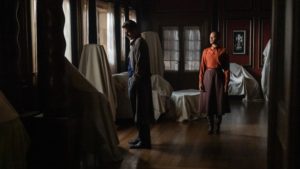
BTL: Is the house exteriors anywhere near where you shot the interiors, presumably on stages
Kniest: It was a bit of a drive. It was a farm south of Vancouver, and it’s probably like a 40-minute drive. They built the grounds, I think it was like five acres, a driveway and topiary areas. There’s a church that they built there, and they dug a lake out and created the lake for the show, which was really interesting, because we shot through the winter, and the lake has to be heated for the actors. We had actors going in the middle of the night, and we had inclement weather. It was quite a production to heat this lake, manage the steam, manage some of the weather, but the crews up there are great. They’re always prepared for rain cover, and we had snow some days. They even brought some steam trucks in to melt snow away, because it’s supposed to happen during the springtime. Of course it snowed three feet one day, but I was just constantly impressed by production and how they handled those challenges and just rolled with it and kept us shooting every day. We didn’t have any down days for weather or anything like that.
BTL: Were you able to shoot all the exterior stuff with all the different directors around the same time or were you going back and forth a lot?
Kniest: We had to go back and forth ‘cause of SAG rules, where they don’t allow us to block shoot, so they brought the directors in and all that stuff, which I just think is cost-effective. We had to keep lake there and all the grounds through winter. I got there in November, and we shot through February, so it’s the dead of winter in Canada. [laughs]
Kniest: Right? Times have changed so much. It’s really interesting for me as a cinematographer, because most of the work is episodic on the small screen. Especially with COVID, I’m not sure what’s going to happen. I would say the writing’s been on the wall for a little while. My anecdotal story is why are you going to spend $100 to go to the theater when for 600 bucks you get an 80-inch TV and surround sound and you just stream Netflix. I’m really concerned about the future of cinema, and as an image maker, it sucks, because I want to see my images on a 60-foot wide screen and not somebody watching it on their phone on the bus. [laughs]
BTL: So this show shot during the winter so you were completely done shooting by the time COVID hit?
Kniest: We were done shooting February 25 right as COVID started to get in. We were very fortunate to finish, and then the thing that was really kind of a challenging is I did post and color-grading remotely, which was very challenging because, we did it on an iPad Pro. I had never done it that way, and how it translates to a real TV and how it translates to other viewing environments. I’m a little nervous about how it’s going to be on my TV on October 9th, just because there isn’t any correlation to how an iPad works. It was very daunting, I have to say. I did fight to get into a color house for just a couple hours to try to touch on every episode to see if there’s any glaring problems. It will be interesting to see. It’s just a necessary evil, I guess. There was no real way around it. It was either that or shelve it and wait, and I’m glad that that didn’t happen. I’m sure Netflix was pining for content, given the fact that everybody’s watched everything twice.
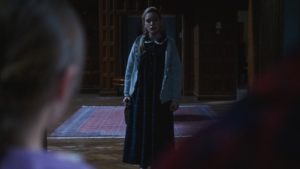
BTL: I’ve had a lot of issues with the movies I watch on my laptop where they’re shot so dark that the screen just looks pitch black, and you can’t really see anything. With your show, I’ve noticed that even when people are walking around in the dark, it’s not pitch black and you can still make everything out.
Kniest: Well, we kind of designed it that way. I think that was something that was important. It’s a constant thing I’ve had for years is like the producers want to see their actors’ faces and stuff, so that’s sort of the trick, is to make it feel dark and heavy and have some weight to it but also still be able to see the expressions and the drama that’s unfolding on the screen. That’s a tough thing with with laptops, too. It’s compression, the blacks get all crawly, and you never know what the settings are on someone’s viewing device and where they’re watching it, if it’s a bright environment. That’s sort of the thing nowadays with all the streaming platforms is what are we posting for? Are we posting for the $30,000 monitor in the color house or do we need to set up an iPad and reference that as we do our color grade, thinking that’s how the majority of the audience may or may not watch it. That’s sort of the learning that we’re all experiencing now, and I think it’s something that’s a tad bit frustrating, but I think it’s something we all need to get our heads around so that we can make sure that it works across all platforms.
BTL: Even the new move to drive-ins. I don’t drive myself, so I don’t know what sort of projection they have there. Have you seen anything at one of the drive-ins?
Kniest: I haven’t, but I do see that there’s some pop-up drive-ins around where people are doing these blow-up screens, which is really fascinating. I’m a tad bit older, so we had drive-ins as kids, and they’re so much fun. Now they’re serving drinks, but I can definitely see a resurgence in the drive-in. It’s tough in New York and L.A. where real estate is so expensive to have 4-acres of parked cars, but I think through the Midwest and the South, we’re going to start seeing a resurgence of drive-ins, because people are going to miss that cinema experience
BTL: Getting back to the show, how important was it to make each episode look and feel different? Even though it’s a series, it does feel like each episode was designed to be its own thing in some ways. Is that how you worked with the different directors, as well?
Kniest: Well, not so much. There had to be some continuity with the regular story besides Episode Eight, which is the black and white period piece. I think what happened was, inevitably everybody brings their own kind of taste or flavor to their work. When I came aboard, I was actually encouraged to make it my own. staying within the boundaries, of course. Mike’s mandate was always if you have any questions just refer back to The Haunting of Hill House as sort of a guide track. There was definitely some opportunity to change the look of the show, and I was slightly encouraged to, I think. I have a tendency to move the camera more. I want to make things more fluid. I want to help the editors with edit points, where I think before first episode, it was a bit more static, a little bit brighter. It kind of works with the arc of the story, because in the middle of the season, it starts to get a little bit darker, a little bit heavier, and we start to reveal some of the goings-on and oddities of the manor and some of the ghosts in there. It was a little bit lucky in that sense, but I think if you watch all the episodes back-to-back, you’ll see there’s a little bit of a change there on Episode 6, 7, 8 and 9.
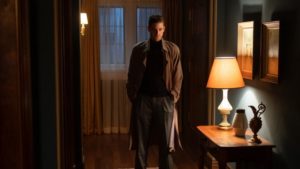
(Note: Potential Spoilers in the next question/response.)
BTL: I read that Mike brought you on to help incorporate some visual surprises, so how much can you say about those without spoiling things, but how much was your department involved in that aspect of the show?
Kniest: Well, there’s a lot. The way the story goes is that people who died in this manor, their soul gets trapped there. There’s a Lady of the Lake that died there in the 1600s, and she kills some people, but there’s other deaths. There’s a thing where she kind of keeps their soul there, and they’re trapped there, and they start to fade away. At the end, Danni, her character sort of takes the ghost with her as she leaves the manor, which frees all the other ghosts to move to the next realm. So all the people that die, we start to sprinkle their ghosts in the backgrounds of places, and they’re really, really hidden, and that was always a conversation in “How bright to make them and how dark to make them?” and where to put them. Mike tries to do things very subtly and not so on the nose, so they’re very, very hidden. That will be one of the things that will be interesting to see with the post process, not really knowing how it translates. I guess that’s one of my my fears is just how it translates to the TV, given the fact that we didn’t post in a normal environment. I’m really curious to see how that works out, but they’re definitely in there, and they’re very well hidden, so you have to really look at and I think that’ll be fun. There’s quite a fan base for Haunting of Hill House, and I hope that same fan base likes to show and spends the time to watch and rewatch and find these little gems.
BTL: I assume a lot of that stuff needs to be worked out with production design and visual effects as well, so was a lot of that stuff already figured out when you came on board?
Kniest: The idea was in place, but the actual execution changed daily. We would try different takes, like “Let’s put them here, let’s put them there,” ust to give the editor options. Time-permitting, we will do several different options for them to kind of hide these ghosts.
BTL: You mentioned doing some work on Mike Flanagan’s new series, so how has that been being on set again?
Kniest: It’s been great. I was filling in for another DP that Mike has worked with for years, Michael Fimognari, who directed To All the Boys: P.S. I Love You, so he had to leave, and he has to leave again a couple times, so I have to quarantine every time I go up there. I filled in with him a little bit, and from what I understood, we were the first and biggest show to get up and running again. I think we started shooting again in late July, and production was really good about dealing with the unions and getting all of our COVID protocol in place and executing the protocol very well, so that we didn’t have any issues. There’s still no positive COVID cases there. We’re lucky B.C. has pretty low case count, but they were really really strict with… we had different pods for different access. All kinds of PPE. If anybody is around the actors, they get tested for COVID regularly. They wear face shields, N95 masks. Everybody’s been really, really good about adhering to this protocol, because I think everybody understands that it’s really important that we get back to work and set a good tone to let other shows get back to work as well. I know some have tried to start up and then they faltered and got shut back down again, so they’ve been really successful in that regard, which is great.
BTL: It’s actually been one of my top priorities since starting at Below the Line in August is to write about how productions are going and what’s being done in terms of protocols and such to help get them up and running. It seems like we’re all going through something none of us have ever been through before.
Kniest: Absolutely, and in production, we’re all problem solvers. That’s the only thing we’re really good at is solving problems. For me, I’m not surprised that some productions have done really well, because inherently, that’s all we do. It’s like, “Okay, what’s the problem? All right, here’s some solutions.” As you know better than I, the pullback has been from the unions, not necessarily feeling like their members are protected, but I can assure you that being on the Midnight Mass set, that health and safety is priority one. It was cool starting up, and they kind of expected to have a spike, but it’s still so low compared to us in L.A. I think they freak out when they have ten people a day that test positive, and we’re having thousands a day.
BTL: As a cinematographer, since your eyes are one of the tools you bring to the table, how are you able to deal with things like having to wear a visor?
Kniest: It’s so frustrating with fogging and reflections and stuff like that. I think even the first ACs, they really have to have clear vision for the way that they pull focus now and monitors. There was a bunch of different goggles that everybody’s tried, and everyone’s found what’s worked best for them. I personally wear the face shield, because I wear glasses, and it’s really hard to wear goggles. You get used to it. I think that if this is what we really have to do to get back to work and to do our creations, it’s not that bad, all things considered. It’s slightly uncomfortable, but it’s not anything that’s a deal-breaker I my mind. I think everybody adapted pretty well to it. At first, you could see people’s frustrations, but there’s just so much at risk that it’s just not worth compromising anybody’s health or safety. Shutting the show down, nobody wants to be that guy.
All nine episodes of The Haunting of Bly Manor are available now on Netflix.





